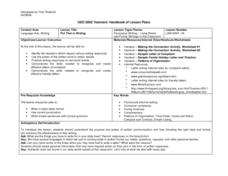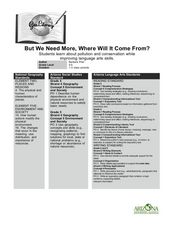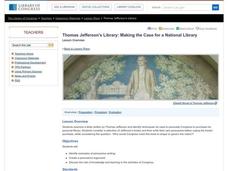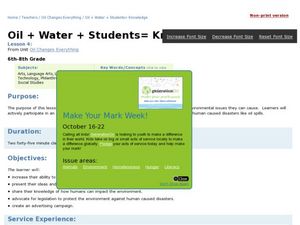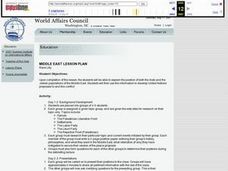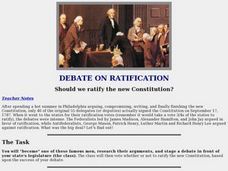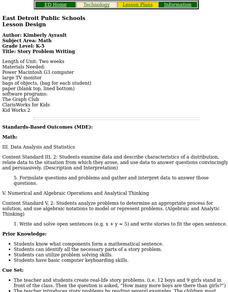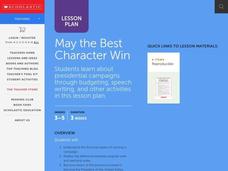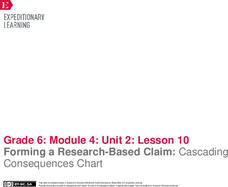Curated OER
Put That in Writing
Students identify life situations which require various writing responses, use the power of the written word to obtain results, practice writing responses to real-world events, and demonstrate the skills needed to recognize and create...
Curated OER
But We Need More, Where Will It Come From?
Students write a persuasive letter and create a poster about pollution and conservation. In this pollution and conservation lesson plan, students learn how humans are the number 1 cause of pollution.
Curated OER
Click! Writing Through Digital Photography
Students take their own digital photographs and scan them onto the computer. For each photograph, they write about them and use the internet to research their subject in the photo more throughly. They are graded based on a rubric and...
Curated OER
Writing: Advertisements
Students explore these web pages to explore how to write good advertisements.
Curated OER
Who Was Responsible for the Start of the Cold War?
Pupils determine who is responsible for the start of the Cold War. For this Cold War lesson, students conduct their own research about the evolution of the war and write essays that reveal their opinion on how the war began.
Curated OER
Create a Cloud in a Jar (Hands-on Version)
Students examine the conditions necessary for cloud formation. In this clouds instructional activity students complete an activity that shows them atmospheric pressure.
Curated OER
Thomas Jefferson's Library: Making the Case for a National Library
Students examine a letter written by Thomas Jefferson. In this lesson on the Thomas Jefferson Library, students discover a methodology for creative writing by examining Jefferson's letter to congress explaining why they should purchase...
Curated OER
Oil + Water + Students= Knowledge
Students create advertising with the intent of protecting wildlife. In this service learning lesson, students craft advertisements and write persuasive essays regarding the protection of wildlife.
Curated OER
What's in a Name? The Use of Native American Images in Sports
Students discuss and analyze the pros and cons of using Native American names and images to represent sports teams. Using primary sources, including position statements from Native American tribes, interviews with school alumni and...
Curated OER
Middle East Lesson Plan
Students explain the position of both the Arab and the Jewish populations of the Middle East. They use this information to develop United Nations proposals to end this conflict.
Curated OER
Sneetches by Dr. Seuss
Students read "Sneetches" by Dr. Seuss. They complete a story map and write about the topic of prejudice. They role-play star-bellied and plain-bellied sneetches and write a persuasive essay about their experiences.
Curated OER
The Breakfast Busters Persuade Others
Young scholars write persuasive essays about their favorite breakfast cereal after seeing how advertisements are used to influence people.
Curated OER
Language Arts: Creative Writing Devices
Eighth graders review sound and rhythm devices and apply them to their own writing exercises. Next, they interpret the poem, "Where I'm From," as an example of a personal narrative. Using their understanding of poetic devices, they...
Curated OER
Theatre: Persuasive Explorers
Students act like a famous explorer. In this explorer lesson, students research an explorer and act out persuasive arguments in which that explorer might be involved.
Curated OER
Persuasive Text: Vocabulary Charades
Students play charades to act out vocabulary words that have recently been introduced in class. In this vocabulary instructional activity students may work in groups or in pairs.
Curated OER
Debate on Ratification: Should We Ratify the New Constitution?
Students determine whether the Constitution should be ratified. In this U.S. Constitution lesson, students research the roles of famous Federalists and Antifederalists in order to prepare them to participate in a classroom simulation...
Curated OER
Story Problem Writing
Students write story problems which can only be solved with the application of multiplication facts. They write an extra fact that isn't needed to solve. When their partners do the problems, they must cross out the fact that they do need.
Curated OER
Propaganda and Its Effects on WWI
Students learn about propaganda. In this WWI lesson, students define the term propaganda. Working in groups, they are given a packet of postcards and posters used during WWI. They answer questions about their uses and write a summary on...
Curated OER
Description and Modifying: What's On Your Plate?
Students create a food product and an advertisement promoting it. In this description and advertising lesson, students read children's book for inspiration and discover advertising techniques. Students complete their ads and...
Curated OER
Writing Letters
Third graders discover that second graders have written them letters and are anxious to receive letters back. They read the letters and review with the teacher the proper ways of writing letters and then write return letters using words...
Curated OER
May the Best Character Win
Running an election campaign takes money. Class groups must effectively budget money in order to design and purchase sufficient advertising aimed at procuring classmates' votes. After completing an online tutorial, they also write and...
EngageNY
Forming a Research-Based Claim: Cascading Consequences Chart
Is it relevant? Scholars choose a resource from their folders and search for relevant information about the harmful and beneficial consequences of DDT. They mark benefits in one color and harmful effects with another color. They then add...
Bright Hub Education
Advertisement Analysis
Middle schoolers review magazine ads and take a look at some of the most common advertising techniques. From analyzing these ads, youngsters begin to become aware of how advertisers target specific age groups, gender groups, and how they...
Curated OER
SPEECHES TO INTRODUCE
Pupils create multimedia speeches of introduction which focus on women and Hispanics. They introduce their famous person and, using a video camera, video tape their speeches.
